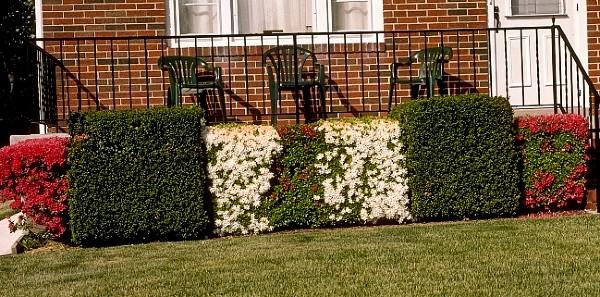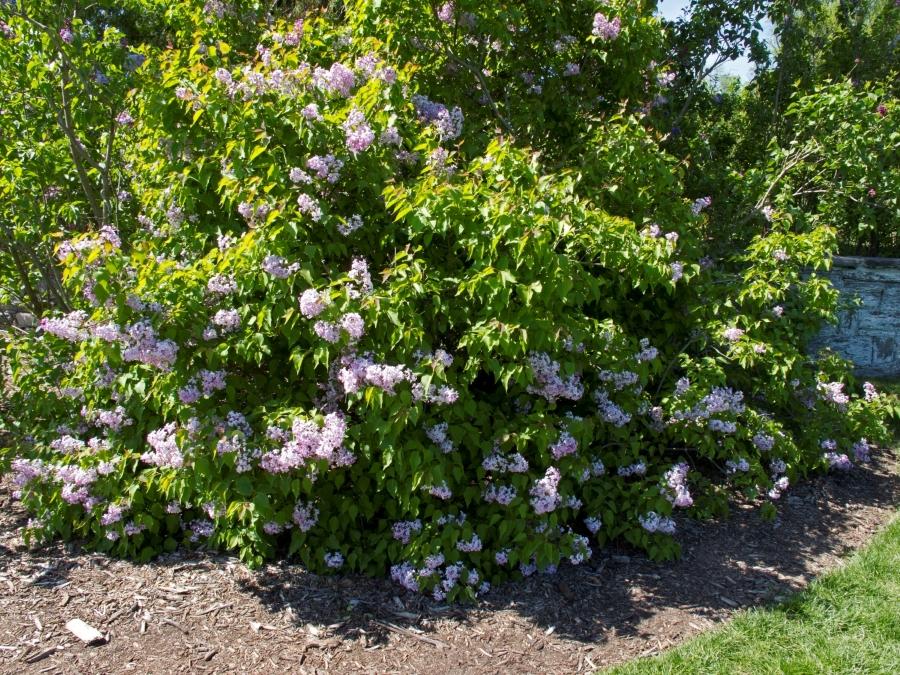Pruning tips
- Before you plant, know the expected mature height and width of the plants you choose. This information can be found on a plant label or online, or you can Ask Extension.
- If a plant is too large for its space, pruning will not be a permanent solution to keeping it a particular size. Pruning does not stop growth; it actually stimulates new growth.
- Pruning and thinning shrubs reduces disease pressure by increasing air circulation and allowing foliage to dry faster.
- Pruning old, overgrown shrubs can improve their appearance. This is called "renewal pruning" and is described in detail below.
Pruning methods
Shearing shrubs

Shearing involves using manual hedge clippers or electric shears to swiftly cut through shrubs to prune them into a variety of geometric shapes. It is the quickest method of pruning.
- Many people like the look of sheared plants but they lose their characteristic shapes and lateral buds along the stems are stimulated to produce even more new growth. It can also reduce flowering.
- Don't shear plants more than once a year, and alternate between shearing and thinning to keep your plants healthy.
- Thinning and heading cuts, not shearing, is the proper way to prune an overgrown shrub.
Thinning shrubs
Is the removal of branches and water sprouts by cutting them back to their point of origin on the parent stem. This is the least conspicuous method of pruning and results in a more open plant without stimulating excessive growth.
- Thinning opens up the plant to air circulation helping to reduce disease pressure and stimulates growth in the interior of the plant.
- This pruning method is used primarily on such plants as crape myrtle, lilac, magnolia, viburnums, and smokebush. It is recommended to periodically thin boxwood. Constantly shearing them creates dense growth that can lead to disease problems.

Thinning cuts before (left) and after (right) Heading back
Is selectively removing the terminal portion of a branch by cutting back to a bud or another branch using a hand pruner.

Heading cuts before (left), correct (center), incorrect (right) - The shape of plants may be controlled, since new shoots develop from dormant buds, by cutting back branches to an outward or inward-pointing bud or branch, depending on the desired direction of growth. Generally, this is an outward-facing bud.
- Heading back will stimulate new growth of shoots and make plants denser.
- A proper heading cut does not leave a stub and is made about one-fourth inch above an active lateral bud or branch.
Renewal pruning
Keeps shrubs, such as azaleas, lilac, and forsythia compact and vigorous and prevents lanky, untidy growth. Renewal pruning should be done in late winter or early spring before the new growth appears. Flowers and blooms will be sacrificed for the season and in some cases at least a year or two afterward.
- Remove the weakest and unhealthiest stems first. Then remove the oldest branches just above ground level, leaving only the younger, more vigorous branches.
- Also, remove stems less than a pencil thickness in diameter.
- Old, poorly developed plants may need to be cut flush to the ground to encourage new branches to develop.
- Stagger renewal pruning over several years to lessen plant shock by cutting out one stem in three each year for some overgrown plants like rhododendrons.
- Remove other stems to open up the center of the bush or improve its general shape. The bush will appear somewhat sparse just after pruning, but new growth will soon fill in the empty spaces.
Individual shrubs

Pruning evergreen shrubs, correct shape (left), incorrect shape (right) The bottom of shrubs should be wider than the top so that light can reach the lower branches, except for naturally vase-shaped shrubs.
- Small-leaved plants, such as boxwood, can be clipped with shears or a hedge trimmer. Shears can damage large leaves, however, causing them to turn brown and die. When pruning large-leaved plants such as rhododendron use pruners, not shears.
- Maintaining a shrub in a specific shape or size may require pruning at least once a year. Repeated heading-back pruning or shearing can eventually make the plant too dense, reducing air circulation and increasing disease, such as Volutellablight and Macrophoma leaf spot in boxwoods. This can be avoided by the use of thinning cuts.
- Hard pruning results in vigorous regrowth. When a shrub is lopsided, hard pruning on the weak side should help that side to fill in.
- Sometimes overgrown shrubs can be “elevated” by pruning them up to resemble small specimen trees.
Hedges
Hedges can be formal or informal. Both can be kept vigorous for years by annually cutting out one-third to one-fourth of the oldest branches near or a few inches above the ground. Do so before new growth starts in spring, using hand pruners, loppers, or curved pruning saws.
Formal hedge
- Pruned with hedge shears to a definite size and shape one or more times a year.
- To establish a formal hedge, small shrubs one to three years old should be cut back to about three to five inches above the ground. This will force new shoots at the base of the plant to develop into a thick, bushy shrub.
- No additional pruning is needed on newly planted hedges until the next spring. When older shrubs are used to start a hedge, about one-third can be cut from the top and sides to develop a thick, bushy hedge of many twiggy stems.
- Regular shearing, along with thinning out of upper branches can keep formal hedges healthy.
- The top of a formal hedge may be slightly rounded or pointed. This helps the plant to shed snow, which could otherwise break branches.
Informal hedge
- Is often a row of shrubs planted close together but allowed to grow naturally, may be pruned annually to thin out the oldest wood or to maintain a desired height and width if it is pruned at all.

Pruning a young hedge. Year 1 (left), Year 2 (center), Year 3 (right) Deciduous (shed their leaves in the fall) hedges that are overgrown, bare-bottomed, or misshapen can be renovated by pruning to one foot below the desired height and trimming frequently for the next few years to the shape and fullness desired.Narrow pyramid or inverted V (see the illustration under shrubs) is the recommended shape for hedges to prevent shading of the lower branches which would then produce thin, weak growth. For example, a hedge five feet high could be three and a half to four feet wide at the base and about a foot wide at the top.
Pruning evergreens
Many evergreens will not tolerate severe pruning.
- When deciding on foundation plants do research beforehand. What will be the size of the plant be in 10 years, 20 years, or at maturity? Do not select a plant that will eventually outgrow its site. Once evergreens have become overgrown it is usually too late to begin corrective pruning and they will need to be replaced.
- Do not cut evergreen branches into old wood. However, yews, junipers, hemlocks, false-cypress, and arborvitae are exceptions and may be headed back in spring or summer. These are the only conifers that will respond to severe pruning.
When to prune shrubs
The time to prune is based on a plant’s flowering, fruiting, or growth habit. When in doubt, prune in early spring. This may mean the loss of flowers for one year, but the shrub will not be damaged. Do not prune in the fall (generally from August to late October), since new growth will not have a chance to harden off before winter.
- Plants that flower before the end of June: Prune immediately after they finish flowering. These include forsythia, azaleas, rhododendrons, and lilacs. Since flower buds develop on these during the prior growing season, fall, winter, or spring pruning would reduce their spring flowering display.
- Plants that flower in summer or autumn: Prune them in the winter or spring before new growth begins; these plants develop flowers on growth produced during the spring. Examples are shrub roses, beautyberry, abelia, and rose of Sharon.
- Delay pruning plants that are grown for their ornamental fruits such as cotoneasters, pyracanthus, and viburnums until after the fruit drops.
- Trim hollies and other evergreens during the winter if their branches will be used for holiday decorations. But, severe pruning of evergreens should be done in early spring.
